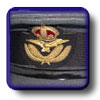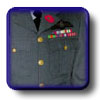Uniforms
In 1925, the Royal Canadian Air Force (RCAF) issued new
uniforms. Commonly referred to as Air Force blues, due to
their rich blue colour, uniforms served a variety
of practical and symbolic purposes. Each button, badge and
insignia served as a symbol to communicate an airman's rank,
classification and nationality.
RCAF u niforms during World War II consisted of a jacket
with four buttons, a belt cinched at the waist, a collared
shirt and black tie, matching pants, black boots and a cap.
All British Commonwealth Air Training Plan trainees wore
what was called a wedge cap. All aircrew trainees wore a
flash of white material on their caps, which indicated that the
wearer was undergoing training. With so many airmen on every base,
it was essential to separate those undergoing aircrew training from
those who were not. niforms during World War II consisted of a jacket
with four buttons, a belt cinched at the waist, a collared
shirt and black tie, matching pants, black boots and a cap.
All British Commonwealth Air Training Plan trainees wore
what was called a wedge cap. All aircrew trainees wore a
flash of white material on their caps, which indicated that the
wearer was undergoing training. With so many airmen on every base,
it was essential to separate those undergoing aircrew training from
those who were not.
 Uniforms
were required to take the harsh Canadian climate into account
and therefore, depending on the season and the occasion,
the airman's dress was different. For example, an airman
on duty would wear something different from while messing,
just as an airman on duty in the summer would wear
different clothing from that worn during the winter. Summer uniforms took on the
same style but were made from a lighter weight and lighter coloured fabric. Uniforms
were required to take the harsh Canadian climate into account
and therefore, depending on the season and the occasion,
the airman's dress was different. For example, an airman
on duty would wear something different from while messing,
just as an airman on duty in the summer would wear
different clothing from that worn during the winter. Summer uniforms took on the
same style but were made from a lighter weight and lighter coloured fabric.
 It
was not until Canadian airmen served overseas in World War
II that a shoulder badge was worn officially. The badge
read "Canada" and was worn to show one's nationality.
Each component of the uniform was to comply with regulation
and this badge was no exception. The top of it was to be
worn 3/4 of an inch below the shoulder seam. Airmen and
airwomen were required to wear this on both shoulders of
all jackets except for overcoats, officers' mess jackets
and bandsmen's dress jackets. It
was not until Canadian airmen served overseas in World War
II that a shoulder badge was worn officially. The badge
read "Canada" and was worn to show one's nationality.
Each component of the uniform was to comply with regulation
and this badge was no exception. The top of it was to be
worn 3/4 of an inch below the shoulder seam. Airmen and
airwomen were required to wear this on both shoulders of
all jackets except for overcoats, officers' mess jackets
and bandsmen's dress jackets.
 Upon
enlisting in the British Commonwealth Air Training Plan
(BCATP), each airman and airwoman received the classification
of Leading Aircraftman (LAC) and Leading Aircraftwoman (LAW).
This was displayed on their uniform by the propeller badge
worn on both shoulders. Once trained in a specialized capacity,
each trainee would receive a new classification and a new
badge to display this. Airmen were granted their Wings in
graduation ceremonies and often rushed back to the barracks
to stitch the badge on to the uniform. Wing badges were
worn on jackets on the left side over the chest. Upon
enlisting in the British Commonwealth Air Training Plan
(BCATP), each airman and airwoman received the classification
of Leading Aircraftman (LAC) and Leading Aircraftwoman (LAW).
This was displayed on their uniform by the propeller badge
worn on both shoulders. Once trained in a specialized capacity,
each trainee would receive a new classification and a new
badge to display this. Airmen were granted their Wings in
graduation ceremonies and often rushed back to the barracks
to stitch the badge on to the uniform. Wing badges were
worn on jackets on the left side over the chest.
 Uniforms
for the Royal Canadian Air Force Women's Division (RCAF WD)
were rather controversial. Many considered the first caps
to be quite unattractive. The first summer uniform, a blue
dress worn with grey stockings was also very unpopular.
The officials at Air Force Headquarters took these problems
into consideration and the uniforms that resulted were both
stylish and of excellent quality. Uniforms
for the Royal Canadian Air Force Women's Division (RCAF WD)
were rather controversial. Many considered the first caps
to be quite unattractive. The first summer uniform, a blue
dress worn with grey stockings was also very unpopular.
The officials at Air Force Headquarters took these problems
into consideration and the uniforms that resulted were both
stylish and of excellent quality.


|
 Heritage Community Foundation Presents
Heritage Community Foundation Presents Heritage Community Foundation Presents
Heritage Community Foundation Presents